|
|
|
Sort Order |
|
|
|
Items / Page
|
|
|
|
|
|
|
| Srl | Item |
| 1 |
ID:
094259
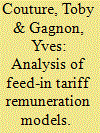

|
|
|
|
|
| Publication |
2010.
|
| Summary/Abstract |
Recent experience from around the world suggests that feed-in tariffs (FITs) are the most effective policy to encourage the rapid and sustained deployment of renewable energy. There are several different ways to structure a FIT policy, each with its own strengths and weaknesses. This paper presents an overview of seven different ways to structure the remuneration of a FIT policy, divided into two broad categories: those in which remuneration is dependent on the electricity price, and those that remain independent from it. This paper examines the advantages and disadvantages of these different FIT models, and concludes with an analysis of these design options, with a focus on their
|
|
|
|
|
|
|
|
|
|
|
|
|
|
|
|
| 2 |
ID:
124466


|
|
|
|
|
| Publication |
2013.
|
| Summary/Abstract |
Renewable energy is becoming a priority for Latin America and Caribbean (LAC) countries because of energy challenges such as demand growth, high dependence on imported fossil fuels, and climate change. As of 2010, 12 LAC countries have implemented formal targets for renewable energy deployment. Some of the LAC countries, namely Argentina, Dominican Republic, Ecuador, Honduras, and Nicaragua, are using feed-in tariffs (FITs) to promote renewables. FITs are long-term, guaranteed purchase agreements for green electricity at a price that can provide project developers a reasonable return on investment. FITs are increasingly popular because if designed well, they can mitigate investor risk in renewables. This article presents a low-risk FIT design and then uses this design to benchmark the existing LAC region FITs.
|
|
|
|
|
|
|
|
|
|
|
|
|
|
|
|
| 3 |
ID:
092854


|
|
|
|
|
| Publication |
2009.
|
| Summary/Abstract |
Renewable electricity supply is a crucial factor in the realization of a low-carbon energy economy. The understanding is growing that a full turn-over of the electricity sectors by 2050 is an elementary condition for avoiding global average temperature increase beyond 2 °C. This article adopts such full transition as Europe's target when designing renewable energy policy. An immediate corollary is that phasing-in unprecedented energy efficiency and renewable generation must be paralleled by phasing-out non-sustainable fossil fuel and nuclear power technologies. The double phasing programme assigns novel meaning to nearby target settings for renewable power as share of total power consumption. It requires organizing in the medium term EU-wide markets for green power, a highly demanding task in the present context of poorly functional markets in brown power. The EU Commission's 2007/2008 proposals of expanding tradable certificates markets were not based on solid analysis of past experiences and future necessities. The keystone of sound policies on renewable electricity development is a detailed scientific differentiation and qualification of renewable electricity sources and technologies, for measuring the huge diversity in the field. We provide but structuring concepts about such qualification, because implementation requires extensive research resources.
Support for renewable electricity development is organized via feed-in prices or premiums, and via quota obligations connected to tradable green certificates. Green certificates are dependent on physical generated renewable power, but separable and no joint products. Contrary to conventional wisdom we argue their separation in cost analysis but firm linking during trade. A few graphs illustrate the importance of assigning qualities to different renewable power sources/technologies. Feed-in systems based on an acceptable qualification perform generally better than certificate markets imposing uniform approaches on a very diverse reality. For a similar reason, uniform and undifferentiated taxation of non-sustainable energy sources cannot replace renewable energy support schemes capable of differentiation.
|
|
|
|
|
|
|
|
|
|
|
|
|
|
|
|
| 4 |
ID:
132678
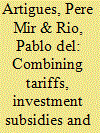

|
|
|
|
|
| Publication |
2014.
|
| Summary/Abstract |
Policy combinations and interactions have received a considerable attention in the climate and energy policy realm. However, virtually no attention has been paid to the analysis of the combination of different deployment instruments for the same renewable energy technology. This neglect is all the more striking given the existence in current policy practice of combinations of deployment instruments either across technologies or for the same technology, both in the EU and elsewhere. What renewable electricity support policies to use and, therefore, how to combine them in order to promote the deployment of renewable energy technologies cost-effectively is a main concern of governments. The aim of this paper is to provide insight on the cost-effectiveness of combinations of deployment instruments for the same technology. A financial model is developed for this purpose, whereby feed-in tariffs (FITs) are combined with investment subsidies and soft loans. The results show that the policy costs of combinations are the same as for the FITs-only option. Therefore, combining deployment instruments is not a cost-containment strategy. However, combinations may lead to different inter-temporal distributions of the same amount of policy costs and, thus, differently affect the social acceptability and political feasibility of renewable energy support.
|
|
|
|
|
|
|
|
|
|
|
|
|
|
|
|
| 5 |
ID:
168696
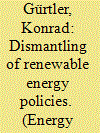

|
|
|
|
|
| Summary/Abstract |
Despite their increasing cost competitiveness, the continued expansion of renewable energy remains dependent on policy support. Moreover, the dismantling of renewable energy policies in a number of former pioneer countries indicates that continued policy support is not a foregone conclusion. Yet, in light of the accelerating expansion of renewable energy, the dismantling of renewable energy policies has captured comparatively less attention than the rapid spread of support schemes. This article seeks to fill this important knowledge gap by developing and testing a framework for the analysis of policy dismantling processes in the renewable energy sector. It applies the framework to conduct a comparative analysis of policy dismantling in Spain and the Czech Republic. Both countries represent European pioneers of renewable energy support who subsequently dismantled their policies. The paper finds that the inter-relationship between policy design and the broader configuration of the political economy in the energy sector are key for understanding dismantling processes. It offers a number of conclusions for the design of more robust renewable energy support policies.
|
|
|
|
|
|
|
|
|
|
|
|
|
|
|
|
| 6 |
ID:
133013


|
|
|
|
|
| Publication |
2014.
|
| Summary/Abstract |
Many advanced industrialized countries have, in recent years, experienced a significant expansion of electricity production from renewables. Yet we know quite little about the dynamics of the underlying policychoices in this area. Using new data on adoptions and changes in feed-in tariff and green certificate schemes in 26 advanced industrialized countries over 20 years, we examine both domestic driving forces as well as international determinants. The findings suggest that three factors play a particularly important role in pushing countries towards market-based support systems: characteristics of the existing energy supply system, a federalist structure of the political system, and EU membership. Particularly noteworthy is the finding that higher shares of fossil and nuclear energy in the national energy supply as well as higher CO2intensity of the economy do not, as we had expected, stand in the way of policies for supporting renewables in electricity production. To the contrary, they increase the likelihood of a country adopting such policies. We also find, however, that higher economic growth and higher growth in solar and wind energy capacity tend to reduce the political appetite for reforms of existing schemes.
|
|
|
|
|
|
|
|
|
|
|
|
|
|
|
|
| 7 |
ID:
179751
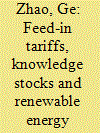

|
|
|
|
|
| Summary/Abstract |
This paper studies the moderating effect of local government intervention on transforming feed-in tariffs and knowledge stocks into renewable energy technology innovation. We examine the key intervention measures for the wind energy sector, using provincial panel data in China over the period 2008–2017. Our results show that local government intervention factors, such as policy count in renewables and R&D expenditure, are significant drivers for technology innovation. However, local green fixed industrial investment has negative implication. Moreover, we find that increasing local policy counts in renewables and augmenting local R&D investment can buffer feed-in tariffs’ effectiveness on innovation performance. Expanding renewable policies, and increasing local fund on R&D program and green fixed industries may enhance the relationship between knowledge stocks and technology innovation. It is suggested that the provinces with over-reliance subsidies should put more emphasis on local renewable development policies and increase the level of R&D expenditure.
|
|
|
|
|
|
|
|
|
|
|
|
|
|
|
|
| 8 |
ID:
099619


|
|
|
|
|
| Publication |
2010.
|
| Summary/Abstract |
The Renewable Energy Sources Act of Germany has been a success story, thanks to the advantages that derive from promoting energy from renewable sources. The way in which renewable energy sources are promoted under the Renewable Energy Sources Act is a pioneering approach that is unprecedented in Germany or any other country. However, this type of support for innovation cannot be continued indefinitely, for if the federal government's target is of obtaining 30 per cent of electricity supplies from renewable sources by 2020, this form of support must be re-examined and further developed. Renewable sources of energy are important not purely for environmental reasons but also because they contribute to energy security. Nevertheless, it is important that the supply of energy be climate friendly, environment friendly and cost effective, not only in Germany but throughout the world.
|
|
|
|
|
|
|
|
|
|
|
|
|
|
|
|
| 9 |
ID:
132655


|
|
|
|
|
| Publication |
2014.
|
| Summary/Abstract |
Renewable energy promotion and its cost are at the heart of the energy policy debate in many countries. The question from an economic perspective is how expensive the promotion of renewable sources through price-based incentive schemes is. This paper addresses this issue empirically. We analyze the Spanish electricity market during the period 2008-2012, where renewable energy production rose by 57%. To determine how expensive it was, we first measure the savings due to the spot price reduction driven by the merit order effect and, second, we compute the amount paid as incentives to green energy by the electricity system; the difference between the two is the net cost of green energy to the electricity markets. We present aggregate results for renewable sources as a whole, as well as individual results for each technology. We show that at the initial stages, when renewable capacity was low, green energy promotion paid for itself (2008-2009); however, from 2010 on, when renewable production reached a relatively high level, it started to impose a positive net cost on the system. Finally, we found substantial differences among technologies: wind energy implied the lowest net cost, while solar photovoltaic was the most expensive.
|
|
|
|
|
|
|
|
|
|
|
|
|
|
|
|
| 10 |
ID:
132748
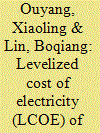

|
|
|
|
|
| Publication |
2014.
|
| Summary/Abstract |
The development and utilization of renewable energy (RE), a strategic choice for energy structural adjustment, is an important measure of carbon emissions reduction in China. High cost is a main restriction element for large-scale development of RE, and accurate cost estimation of renewable power generation is urgently necessary. This is the first systemic study on the levelized cost of electricity (LCOE) of RE in China. Results indicate that feed-in-tariff (FIT) of RE should be improved and dynamically adjusted based on the LCOE to provide a better support of the development of RE. The current FIT in China can only cover the LCOE of wind (onshore) and solar photovoltaic energy (PV) at a discount rate of 5%. Subsidies to renewables-based electricity generation, except biomass energy, still need to be increased at higher discount rates. Main conclusions are drawn as follows: (1) Government policy should focus on solving the financing problem of RE projects because fixed capital investment exerts considerable influence over the LCOE; and (2) the problem of high cost could be solved by providing subsidies in the short term and more importantly, by reforming electricity price in the mid-and long-term to make the RE competitive.
|
|
|
|
|
|
|
|
|
|
|
|
|
|
|
|
| 11 |
ID:
090085


|
|
|
|
|
| Publication |
2009.
|
| Summary/Abstract |
The development of renewable energy as a major component of efforts to combat climate change serves as the impetus for the location of energy production facilities in coastal ocean space. Yet, while many coastal nations see offshore renewable energy development as an important way forward, the speed and manner in which these efforts take shape vary dramatically. This paper assesses the role of coastal nations' domestic legal and policy frameworks in the siting of offshore renewable energy facilities in areas under federal jurisdiction. It focuses on two nations-Germany and the United States. Both have articulated their interest in renewable offshore energy, but while Germany has approved many offshore sites, recent US proposals have for the most part stalled. Based on a review of legal and policy documents, laws and regulations, academic literature, and interviews, this research identifies and compares factors that figure most prominently for the development of offshore renewable energy policies. Comparisons are organized under four categories: the regulatory framework, the public's role in siting, targeted economic mechanisms, and indirect mechanisms. The paper concludes with observations about prominent supports and impediments and suggestions for further research.
|
|
|
|
|
|
|
|
|
|
|
|
|
|
|
|
| 12 |
ID:
180113
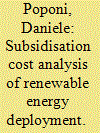

|
|
|
|
|
| Summary/Abstract |
The feed-in tariff programme Conto Energia spurred a massive deployment of photovoltaic (PV) technology in Italy, increasing domestic PV capacity by about 17.6 GW from 2006 to 2018. While the benefits in terms of avoided greenhouse gas emissions and fossil-fuel imports and use have been numerous and obvious, the costs of this incentive scheme were hefty, reaching EUR 5.9 billion in 2018. Herein, the net subsidisation costs of Conto Energia are estimated in the frame of an ex-post scenario analysis. A counterfactual scenario having the same avoided greenhouse gas emissions as those achieved by the Conto Energia program is constructed. This alternative scenario is built on an increase in energy efficiency investments and a more linear path of PV deployment while still reaching the same level of cumulative PV capacity by 2018 as the historical pathway. The counterfactual scenario has significantly lower subsidisation costs (−70%) relative to Conto Energia, with EUR 25 billion vs. EUR 83 billion. The estimated net subsidisation cost of Conto Energia is as high as EUR 58 billion, about 3% of Italian gross domestic product.
|
|
|
|
|
|
|
|
|
|
|
|
|
|
|
|
| 13 |
ID:
092725
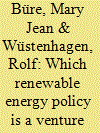

|
|
|
|
|
| Publication |
2009.
|
| Summary/Abstract |
Governments around the world have adopted ambitious targets to increase the share of renewable energy and reduce greenhouse gas emissions. They pursue a variety of policy approaches to achieve these targets. It has been a popular theme for contributions in Energy Policy to investigate the effectiveness of such policies. This article adds a new perspective to the debate, namely looking at the policy preferences of private investors in innovative clean energy technology firms. We surveyed 60 investment professionals from European and North American venture capital and private equity funds and asked them to assess the effectiveness of various policies, in terms of stimulating their interest to invest in innovative clean energy technologies. In addition to quantitative rankings, we use qualitative interview data to capture additional information on why investors prefer some policies over others. The combined analysis compensates for the inherent limitations of a quantitative ranking using generic policy types. The results of this exploratory analysis demonstrate that, all other things being equal, investors in our sample perceived feed-in tariffs to be the most effective renewable energy policy. The overall preference for feed-in tariffs is even more pronounced among investors based in Europe and with higher exposure to clean energy.
|
|
|
|
|
|
|
|
|
|
|
|
|
|
|
|
|
|
|
|
|